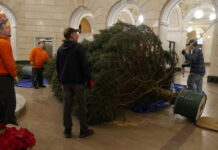County and State disagree on the root cause of the issue
Luzerne County’s Election Bureau has identified an “isolated incident” that caused 31 voters to receive two Nov. 4 general election mail ballots, county Election Director Emily Cook announced Tuesday.
The duplicate ballots stemmed from an “apparent SURE system error,” her release said.
Officially the Statewide Uniform Registry of Electors, SURE is the database that keeps voter registration information in all 67 counties.
“Following a comprehensive review of all 25,000 mail ballot records distributed to voters last week, the bureau confirmed that this issue was limited in scope,” the release said.
The county reported the matter to the Pennsylvania Department of State and provided the state with all relevant information “to assist with identifying the root cause of the SURE system error that caused duplicate ballots to be generated without triggering a warning or rejection upon receipt of the applications,” it said.
However, the state provided a different cause for the error, providing the following statement indicating the problem stemmed from a county error, not the SURE system:
“After investigating this issue, the Department of State determined that Luzerne County inadvertently and incorrectly generated duplicate mailing labels for 30 voters. This issue was isolated to Luzerne County. The voter registration database, known as SURE, does not allow more than one ballot to be counted for one voter in any election. The Department is committed to working closely with our counties to ensure Pennsylvania once again holds a free, fair, safe, and secure election this November.”
Cook said Tuesday evening she wholeheartedly stands by her statement that the state SURE system was at fault.
After discovering the problem, the bureau took immediate action to begin contacting the affected voters, informing them of the situation, and ensuring that only their valid ballot is submitted and counted, her release said.
The second duplicate ballots were promptly cancelled in the SURE system before any ballots were accepted by the bureau, it said.
“To further safeguard the integrity of the election process, the bureau will closely monitor the return of ballots to ensure that only one ballot per voter is counted,” the release said, adding that the bureau “remains committed to transparency, accuracy, and the security of every vote.”
Cook said she learned about the matter from two impacted voters.
Each mail ballot comes with a white outer return envelope containing a bar code that must be scanned upon arrival in the bureau to identify the voter.
Officials have said this unique bar code is a safeguard because it only allows one ballot per voter.
However, Cook claimed the 31 voters in this situation each received ballots with two unique bar codes, which she said raises questions about why SURE permitted a second ballot to be generated.
Cook said there was no common denominator because the 31 voters were from different municipalities, included both Republicans and Democrats, and had their ballot requests approved on different dates by different workers.
Once she verified the first caller reporting the issue had a valid concern, Cook said she had to sort a spreadsheet of 25,000 mail ballot voters multiple times and painstakingly analyze the results to pinpoint those that had received two ballots.
Cook believes the mail ballot processing system would have flagged the second ballot if a voter cast both, but she cannot know for certain because she never encountered a situation in which SURE allowed the issuance of two ballots with different bar codes to the same voter.
County Manager Romilda Crocamo said Tuesday evening the information provided by the state “differed greatly from information provided to the county” when the matter was first reported and “over several conversations.”
“Assuming that the state’s excuse is accurate, how broken is the SURE system if it cannot safeguard against a county inadvertently sending two labels for the same voter?” Crocamo said. “What the state is saying is that individuals in the county can override the SURE system, which means there are no safeguards. There is nothing sure about the SURE system.”
The way the system has been explained, the bureau must void an existing bar code in the state system in order to activate a second ballot for a voter. For example, this voiding approach is used when a voter indicates a ballot was not received and requests a new one.
Voters among the group of 31 impacted who did not yet speak to the bureau should call 570-825-1715 or email elections@luzernecounty.org, Cook said.
Ballots returned by the 31 voters will be segregated to ensure their votes are counted, Cook said.
The bureau issued mail ballots last week, but Cook said no returned ballots had been recorded as received by the bureau when the problem with the 31 voters was discovered.
The state had announced plans in March to implement a new streamlined elections management system that will replace SURE and other current elections-related programs.
Civix, a leading provider of government technology solutions, was selected to provide the new system following a public procurement and review process, Secretary of the Commonwealth Al Schmidt said at the time.
The new system will be implemented in phases and is scheduled for completion by 2028, the state said.
The SURE system has served as the statewide voter database since 2003, and Schmidt said in a release it has undergone extensive upgrades and security enhancements in the last 22 years.
Regarding county mail ballots, a drop box has been set up inside the county’s Penn Place Building at the corner of Market Street and Pennsylvania Avenue in Wilkes-Barre for voters interested in that option. The second drop box in the county-owned Broad Street Business Exchange in Hazleton is expected to be set up Wednesday, Cook said.
A schedule of the drop box availability will be posted on the election page at luzernecounty.org.
While the county director states there are 31 duplicate mail ballots from this error, the state has determined 30 voters were impacted by this situation.
Reach Jennifer Learn-Andes at 570-991-6388 or on Twitter @TLJenLearnAndes.




